|

Outstanding Performance
A San Diego performance of Verdi's 'Rigoletto'
impresses MARIA NOCKIN
Verdi based two of his early operas, Ernani, first seen in 1844, and Rigoletto, premièred in 1851, on the works of French writer Victor Hugo. He wanted his works to bring serious drama to the musical stage, so he tried to expand the conventions and the boundaries of his art form. Thus, his works began to allow the performers more room for intensity of characterization and interpretation in their roles. Verdi admired great dramatists from several cultures. Before he wrote Rigoletto he had already set Shakespeare's Macbeth to music and composed Luisa Miller, which is based on a Schiller story.
The composer was very fond of Hugo's work and said that his Le Roi S'Amuse was 'the greatest subject and possibly the greatest drama of modern times'. He considered the jester, whom Hugo called Triboulet, to be on a par with the characters of Shakespeare. When Verdi began to compose Rigoletto, he called it La maledizione and used Hugo's names and settings. Only when the censors refused it, were the names changed and the setting transferred from the French court to an anonymous duchy.
After the monumental success of Nabucco in 1842, Verdi began to turn out operas one after the other. He later called the time from 1842 to 1859 his 'galley years'. Rigoletto was written right at the middle of that busy time. It followed Stiffelio, which had given him catastrophic problems with censors. As a result, when working on Rigoletto, he considered the possibility of censorship right from the beginning.
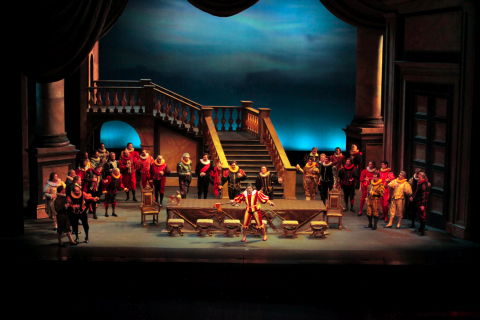
A scene from San Diego Opera's production of Verdi's 'Rigoletto'. Photo © 2009 Ken Howard
|
Even so, librettist Francesco Maria Piave's first script was rejected by the Venetian censors and the second was not dramatic enough to suit Verdi. Only on the third try did Piave succeed in pleasing both. The opera's première on 11 March 1851 was a tremendous success and, unlike many other currently popular operas, Rigoletto has never been out of the commonly played repertory. A decade after it was first performed, it had been seen in two hundred and fifty opera houses around the world.
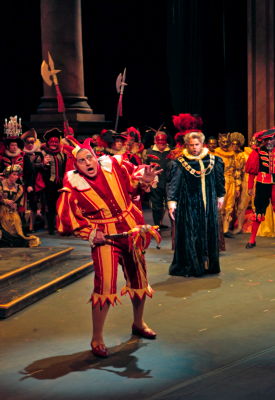
Lado Ataneli as Rigoletto (foreground, left) with Scott Sikon as Count Monterone (background) in San Diego Opera's production of 'Rigoletto'. Photo © 2009 Ken Howard
|
On 28 March 2009, San Diego Opera presented a traditional production of Rigoletto that was originally seen at the New York City Opera. The all-star cast featured Georgian baritone Lado Ataneli as an intense and provocative jester whose mind was as deformed as his body. His only redeeming feature was his love for the daughter he kept imprisoned in their home.
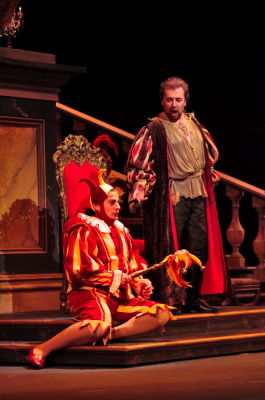
Giuseppe Gipali as the Duke of Mantua and Lado Ataneli as Rigoletto in San Diego Opera's production of 'Rigoletto'. Photo © 2009 Ken Howard
|
Ataneli has a rather rough sounding voice and he used it to great advantage in this role. When he confronted the courtiers singing 'Cortigiani vil razza dannata' from atop a banquet table, he made a stunning impression. Here Rigoletto's long smothered rage broke loose for a moment, but he soon began to plead with the courtiers when he realized that the loss of his temper would only bring him more trouble. Both his actions and his vocal coloration changed completely as he begged Marullo for some sign of compassion.
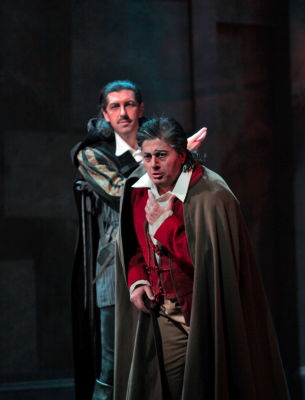
Arutjun Kotchinian as Sparafucile and Lado Ataneli as Rigoletto in San Diego Opera's production of 'Rigoletto'. Photo © 2009 Ken Howard
|
L'ubica Vargicová is an excellent coloratura soprano and she was the picture of youth and innocence as the jester's daughter, Gilda. She sang with secure radiant tones and her 'Caro nome' flowed over the audience with waves of iridescent sound. Tenor Giuseppe Gipali was ill and his voice seemed smaller than those of his colleagues at first, but after Act I he sang with burnished bronze sonorities. A good actor, he had a passionate scene with the enchanting, silken-voiced Kirstin Chávez as the sex kitten, Maddalena.
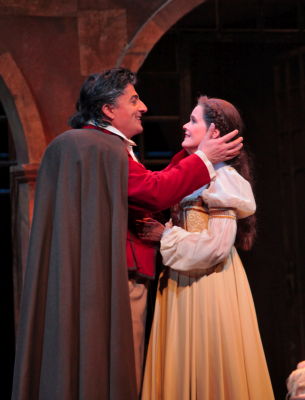
Lado Ataneli as Rigoletto and L'ubica Vargicová as Gilda in San Diego Opera's production of 'Rigoletto'. Photo © 2009 Ken Howard
|
Joseph Hu as Borsa and Malcolm MacKenzie as Marullo were energetic and convincing courtiers. Crystal Jarrell was a decorative Countess and a pleasant voiced Page. Scott Sikon is making a fine career as a singing character actor and as Monterone he delivered a withering curse. Arutjun Kotchinian was an evil Sparafucile who showed the last vestiges of whatever honor he once had when he argued with his sister over the morality of killing a different victim from the one for which he was being paid. He is a fine bass with clear, rich low notes.
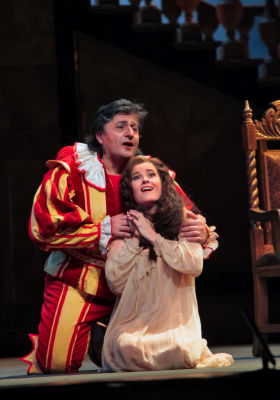
Lado Ataneli as Rigoletto and L'ubica Vargicová as Gilda in San Diego Opera's production of 'Rigoletto'. Photo © 2009 Ken Howard
|
The Act III Quartet was beautifully sung and each singer's line was audible throughout. Under the excellent leadership of Edoardo Müller whose tempi were never too fast or too slow, the San Diego Symphony played with accuracy and well blended sounds. Timothy Todd Simmons' chorus sang with skillful precision as they provided a colorful background for the ducal court. All of the dramatic action that made this performance so outstanding was due to the expert guidance of veteran stage director Lotfi Mansouri. He made the play written into the libretto come to life on stage.
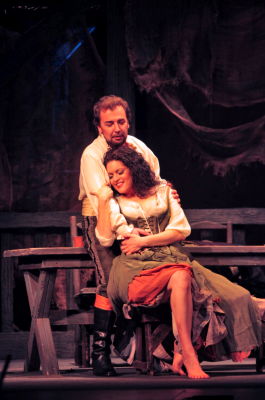
Giuseppe Gipali as the Duke of Mantua and Kirstin Chávez as Maddalena in San Diego Opera's production of 'Rigoletto'. Photo © 2009 Ken Howard
|
Having presented a frequently-given opera in March, the San Diego company now moves on to something less well known. The last weeks of April 2009 will bring in Benjamin Britten's searing Peter Grimes with star tenor Anthony Dean Griffey.
Copyright © 5 April 2009
Maria Nockin,
Boston USA

| 
